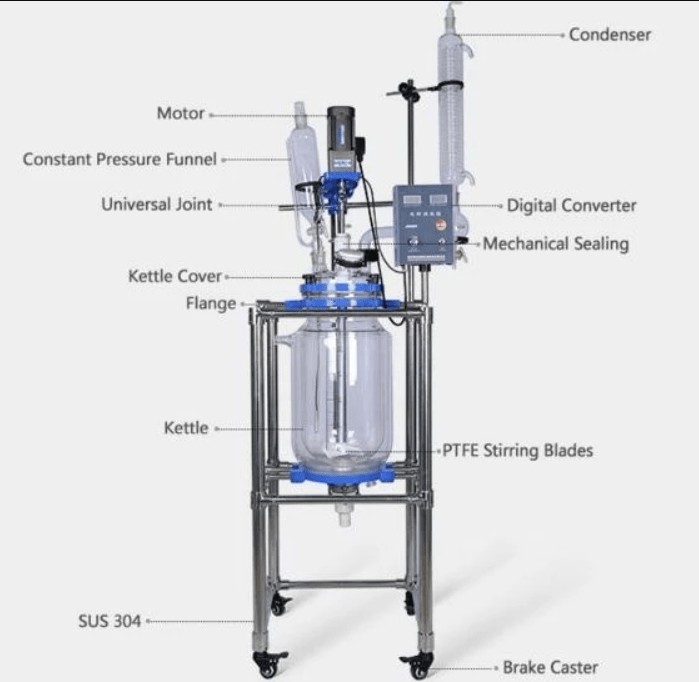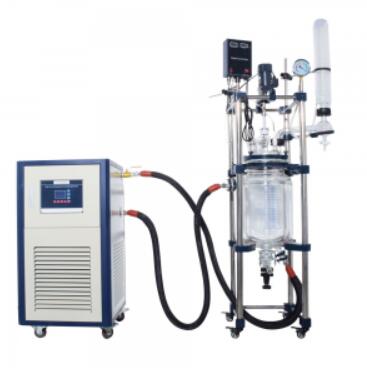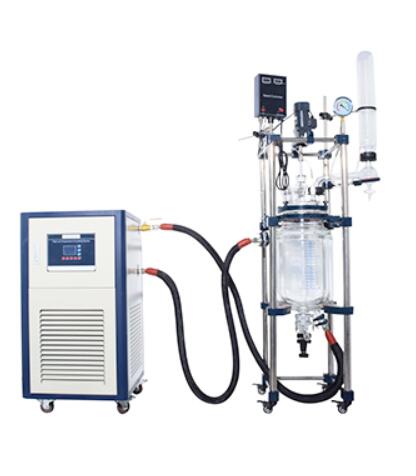
The chemical glass reactor is a vessel used to carry out chemical reactions. The chemical glass reactor regulates conditions such as temperature and pressure, which bring about the ideal condition for the chemical reaction.
With a glass reactor, you can control the heating, mixing, evaporation, and cooling of the condensate. The chemical reactor can be applied in laboratories to carry out chemical reactions. It is also applicable in industries during the chemical production of different materials. The glass chemical reactors come in different sizes.
Researches can specify the size to carry out different chemical processes. Small glass chemical reactors can be used during batch processes while large vessels are applied in large chemical production plants. Some of the processes where the chemical glass reactor can be applied are distillation processes, purification of substances and sample purification. The glass used in making the vessel is highly resistant to temperature and the chemical involved in the processes.
Chemical Glass Reactor Design

A chemical glass reactor provides you with easy control of different parameters using the chemical reaction. For instance, the researchers can control the temperature and pressure of the ingredients during the chemical reaction. It can incorporate valves to discharge the final products, among other features.
A simple chemical glass reactor design will include a mechanism to regulate temperature and pressure. The ingredients have to be subjected to a given condition to allow for the proper working of the ingredients involved in the chemical reaction.
1. Controls
The ingredients have to be housed in a vessel. The vessel is then used to house the chemical reagents. The reagents have to be subjected to different conditions for the best chemical reaction. For example, scientists can provide activators such as enzymes, among other compounds aimed at improving the reaction time.
2. Discharge valves
The discharge valves act as part of the controls. When the reagents are exposed to different conditions, they tend to react and increase in volume. The increase in volume and pressure is controlled through the discharge valve. The discharge valves should incorporate safety features to avoid accidents.
There are different designs of the discharge valves. It is necessary to check on the size of the reactors before integrating the discharge systems.
3. Temperature regulation
For the chemical reaction to progress fast, there is a need to control the temperature. A glass reactor design should incorporate the mechanism of controlling the temperature. Modern designs have automated systems that make the process of temperature regulation easy.
There is a need to keep watch of the temperature at which the chemical reaction is operating to avoid cases where the reagents can stop. Some chemical reactions are temperature driven, which makes it necessary to check on the temperature control.
The Specifications of WKIE Lab Glass Reactor
| Model | S212-05 | S212-10 | S212-20 | S212-50 | S212-100 | S212-200 |
| Reaction Volume(L) | 5L | 10L | 20L | 50L | 100L | 200L |
| Jacket Volume(L) | 2L | 5L | 8L | 12L | 18L | 25L |
| Reactor Material | High quality borosilicate 3.3 glass | High quality borosilicate 3.4 glass | High quality borosilicate 3.5 glass | High quality borosilicate 3.6 glass | High quality borosilicate 3.7 glass | High quality borosilicate 3.8 glass |
| Support Frame Material | Stainless steel 304 and coated aluminum | Stainless steel 304 and coated aluminum | Stainless steel 304 and coated aluminum | Stainless steel 304 and coated aluminum | Stainless steel 304 and coated aluminum | Stainless steel 304 and coated aluminum |
| Neck No. On Lid | 5 | 6 | 6 | 6 | 6 | 6 |
| Rated. torque(N.cm) | 140 | 177 | 177 | 177 | 285 | 550 |
| Motor power(W) | 90 | 120 | 120 | 120 | 200 | 370 |
| Rotating speed(rpm) | 0 ~ 600 (customizable) | 0 ~ 600 (customizable) | 0 ~ 600 (customizable) | 0 ~ 600 (customizable) | 0 ~ 600 (customizable) | 0 ~ 600 (customizable) |
| Power supply | 220V or 110V / 50-60HZ | 220V or 110V / 50-60HZ | 220V or 110V / 50-60HZ | 220V or 110V / 50-60HZ | 220V or 110V / 50-60HZ | 220V or 110V / 50-60HZ |
| Discharge | PTFE (Teflon) bottom discharge valve with no deadspace | PTFE (Teflon) bottom discharge valve with no deadspace | PTFE (Teflon) bottom discharge valve with no deadspace | PTFE (Teflon) bottom discharge valve with no deadspace | PTFE (Teflon) bottom discharge valve with no deadspace | PTFE (Teflon) bottom discharge valve with no deadspace |
| Pressure Range | Full vacuum to atmosphere | Full vacuum to atmosphere | Full vacuum to atmosphere | Full vacuum to atmosphere | Full vacuum to atmosphere | Full vacuum to atmosphere |
| Max jacket pressure | 0.5 bar | 0.5 bar | 0.5 bar | 0.5 bar | 0.5 bar | 0.5 bar |
Types of Chemical Reactors

There are several types of chemical reactors. You need to study the different types of reactors available before you can proceed to purchase one. Chemical reactions where the different reactors can be applied are various.
Thus, there is a need for you to check on the requirements for a given chemical reaction before you can proceed to apply a given glass reactor. The chemical glass reactors come with several benefits as well as drawbacks. And you should know all of them.
- Continuous flow glass reactor

A continuous flow glass reactor is a reactor where a chemical reaction takes place on several channels. The use of several microreactors contributes to making the whole reactor more effective. Some of the reasons why experts prefer the continuous flow reactor are high energy efficiency.
The individual reactors, when combined together, lead to high energy consumption, which can contribute to a lot of savings in the long term. The reaction speed is also improved through the application of the continuous glow glass reactor. There are cases where experts look for ways they can speed up the process. The use of special design chemical reactors plays a great role.
Other reasons why the continuous flow reactor can be applied include the following:
-Safety
The use of several microreactors avoids the accumulation of pressure or energy, which can lead to fatal accidents. The micro-units can be managed easily, which minimizes the issue of accidents. Safety is taken seriously when designing reactors.
-Scalability and reliability
It is more reliable to have several reactors that contribute to the final results. It is unlike when the whole process relies on a single reactor can multifunction and brings the process to a standstill. With the application of the microreactors, it is easy to realize the best results in the process.
- Batch glass reactor

A batch reactor is a single glass reactor that is used for test purposes. Some processes should be run on pilot mode from where the researchers will know their effects.
For example, the researchers have to react to small samples of raw materials and monitor the process in a lab from where they can decide to deploy the process in full scale. Batch reactors play a crucial role in allowing the scientists to have the processes under control in a small environment from where they can decide to deploy them on a large scale.
- Photochemical glass reactor

A photochemical reactor is simply a vessel that is designed to utilize the energy from the sun during a chemical reaction. Some chemical processes, such as the synthesis of vitamin D, require energy from the sun. Chemical reactions where energy from the sun is required are undertaken in photochemical reactors.
The reactors have several features that allow scientists to take into account the effect of UV rays in the chemical reactions. The units allow for efficient and precise control of UV lights during scientific experiments. They come in different sizes and designs to meet the needs of a wide range of experiments.
The Operations of Chemical Glass Reactors
For the glass reactor to perform the reactions of different types of media, you have to check if corrosions are in the medium of the materials. When the result is violent, and a lot of smoke is being produced, high temperatures or even flammable, explosive chemical reactions, high pressure or medium that contains chloride ions, fluoride ions and other reactions that are very corrosive, you have to consider a unique design of glass reactor to perform these.

- When the medium of reaction is loaded, you should observe it not exceed 2/3 of the liquid level mark.
- You should not disassemble the glass reactor with pressure as you are working on the reactions. This is because the reaction vessel is prohibited from working over-temperature or pressure.
- The jacket layer of the glass reactor conducts heat from heated hot oil. When increasing the level of heat, you have to be attentive not to mix water with oil. Also, the heat of oil where it is conducted should be checked regularly.
- When conducting the reaction and you realize any abnormal sound from the isolation sleeve, you have to stop the machine immediately to release pressure and try to find out if there is abnormality inside the mixing system. Check the mixing shaft’s momentum. If you realize that there is a significant momentum, then replace the sliding sleeve.
- You have to connect the voltage according to the voltage in operation of the controller; for a single-phase should be 220V and 380V if it is a three-phase. Do not connect a live wire or connect in reverse.
- To make the glass reactor usually operate and for personal safety, you have to connect the earthing wire. When running, you should be careful with gas, other flammables, and explosives to avoid dangers.
- After determining the final temperature for the reaction, you should not change the value settings during the hearting process to avoid temperature overshoots.
- The kettle’s jacketed layer of glass can provide temperatures as high as 3000c and can as well give lower temperatures of up to -800c.
The Safety of Chemical Glass Reactors

1. Cause of Flammable Gases
The flammable gases are known to cause accidents unpredictably, and the origins of such accidents can be a glass reactor that NO cycling weakening integrity of the structure, which causes micro-fissures into the glass that hence causes contaminations. There might be another accidental cause like contamination or impurity being into a closed reactor which can cause side reaction, therefore, creating a rapid response is exothermic.
2. Possible Action Taken
The lab should be closed down immediately, so all safety procedures are reviewed. Some investigations should also go on hence completing research group retraining. No, any flammable has permitted not until full implementation of safety procedures like the chemical glass reactors.

3. How To Prevent Emission Of Toxic Gases

Safety chemical glass reactors are essential in such a scenario that one must wear and also face shield themselves. The safety glasses will prevent the eyes of victims from getting hurt, and these glasses are available in the lab. The chemical glass reactors being present also make it helpful for everyone entering the lab.
The lab coat is essential too when handling the hardest as materials which can prevent more arm cuts. When chemicals are all over in the lab, then it could be better to take off a lab coat that has been contaminated which minimizes all chemical contacts in the body.
There must be a careful investigation conducted on the glassware before the pressure is applied. When using it, lab glassware can get weak mostly when temperatures are not stable there. There should be an inspection process that needs to be identified by experts and experienced glassblowers.
Fume hood can be beautiful if you work according to it, so the body and your head are fully protected. Ensure you put on gloves for protection too to stop exposing your body parts. Apart from only glass protectors, the researchers must use those tools which do body parts as an alternative to staying risking themselves more.
There should also be a pressure relief in that, if there is much pressure on the lab, then look for the alternative to relieve it which will prevent reactors from failing. It is an important part when you work with chemical compounds that are air sensitive.
Chemical Glass Reactor Price

The chemical glass reactor price can range from $500 to $50,000. It depends on several factors. The design of the glass reactor can contribute to its price. Some models incorporate several features, and they are priced highly. The size of the glass reactor also matters a lot. Some small glass reactors can cost you a few dollars. They can process a few reagents at a time.
For the case of large reactors, they tend to cost a lot of money, and they will allow you to achieve different processes. The place where you buy the glass reactor matters, some brands are cheap when compared to others. Ensure you research on your given needs and the type of reactor you would like to buy before ordering. It is easy to buy a glass reactor online. You get the chance to compare the prices in several dealers before making the final decision. And don’t forget, WKIE Lab always provides you with the most cost-effective chemical glass reactors. If you need them, please leave your e-mail address.

